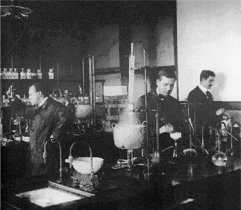The Founding of Clinical Chemistry
Donald D. Van Slyke (1883-1971) pioneered chemical techniques that allowed physicians, for the first time, to analyze blood samples quantitatively in order to diagnose disease and monitor disease progress. In the late 19-teens he invented an apparatus to measure oxygen and carbon dioxide in blood. With this device he could detect acidosis—an accumulation of acid in the blood—in patients at the Rockefeller Hospital with diabetes, before fatal clinical symptoms developed. Later, Van Slyke's interest in quantifying blood gases, as well as substances in other body fluids, led him to study the changes in metabolism, blood chemistry, and urine excretion that characterize kidney diseases. Although he was a chemist, and not an MD, with the hospital's medical staff he oversaw the care of hundreds of kidney patients at the Rockefeller Hospital in the 1930s and 1940s. Van Slyke's quantitative techniques were widely adopted, and the so-called Van Slyke apparatus became standard equipment in clinical and research laboratories before electronic instruments such as spectrophotometers were available.

Donald Van Slyke (center) working in P.A.T. Levene’s Founder’s Hall chemistry laboratory, 1908. Courtesy of the Rockefeller Archive Center
Beyond clinical research, Van Slyke's many contributions to understanding the physiology of blood and of kidney function in health and disease include: quantification gas and electrolyte equilibria in blood, as well as the organic and inorganic constituents of blood; a physico-chemical description of the role of hemoglobin in oxygen and carbon dioxide transport in blood; quantification of blood chlorides, urea, and ketone bodies in blood and urine; studies of the metabolism of proteins and amino acids; and discovery of a new amino acid, hydroxylysine.
Donald D. Van Slyke received the BA and PhD degrees in chemistry at the University of Michigan. In 1907 he joined the Rockefeller Institute as an assistant to chemist Phoebus A.T. Levene. Levene arranged for Van Slyke to spend the year of 1911 in Berlin, in the laboratory of Emil Fischer, then the world's most eminent chemist. In 1914 Van Slyke was appointed chief chemist of the new Rockefeller Institute Hospital. Some of his most important work on gases in blood was done during a period spent at Peking Union Medical College, with Chinese collaborators. After his retirement from Rockefeller in 1948, Van Slyke continued his research at the newly established Brookhaven National Laboratory. His achievements were recognized with numerous awards and honorary degrees, including the National Medal of Science in 1965. He was elected to the U.S. National Academy of Sciences, and he was the author, with J.P. Peters, of the first textbook of clinical chemistry.

Diagram of portable manometric apparatus. From Quantitative Clinical Chemistry by Peters, J. and Van Slyke, D., 1932
Selected Publications
Van Slyke DD. Studies of acidosis. XVII. The normal and abnormal variations in the acid-base balance of the blood. J Biol Chem, 1921, 48:153
Van Slyke DD, Stillman E, Moller E, Ehrich W, McIntosh JF, Leiter L, MacKay EM, Hannon RR, Moore NS, and Johnson C. Observations on the courses of different types of Bright's disease, and on the resultant changes in renal anatomy. Medicine, 1930, 9:257
Peters JP and Van Slyke DD. Quantitative Clinical Chemistry, vol. 1: Interpretations. (Baltimore: Williams and Wilkins), 1931; rev. 1946
Further Reading
Corner GW. A History of the Rockefeller Institute, 1901-1953. New York: Rockefeller Institute Press, 1964
Hastings AB. Donald Dexter Van Slyke (1883-1971): A Biographical Memoir. Washington, DC: National Academy of Sciences, 1976, 48: 307-360
Hastings AB. Donald Dexter Van Slyke. J Biol Chem, 1972, 247: 1635-1640
http://www.jbc.org/cgi/reprint/247/6/1635
Rosenfeld L. Otto Folin and Donald D. Van Slyke: Pioneers of Clinical Chemistry. Bull Hist Chem, 1999, 24: 40-47
